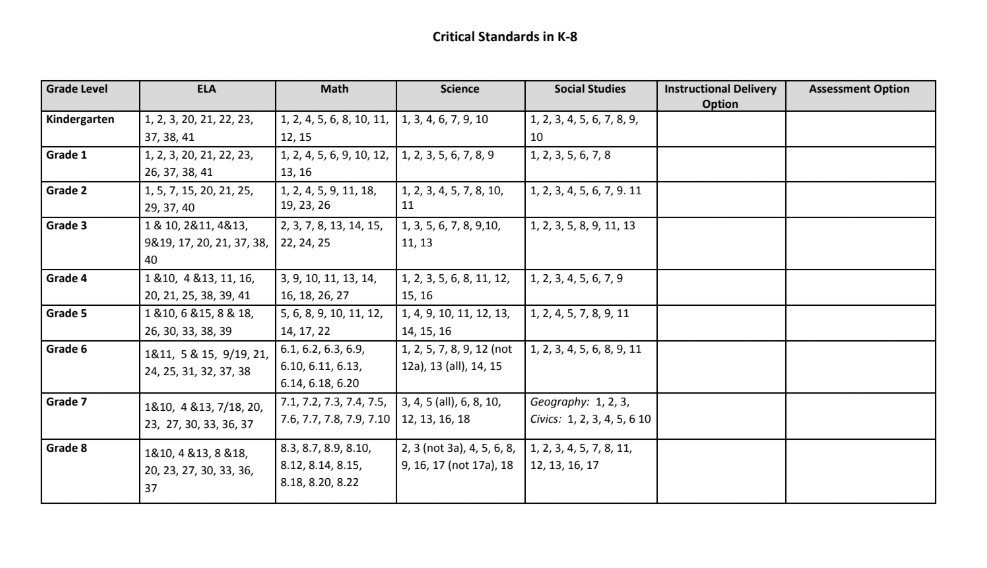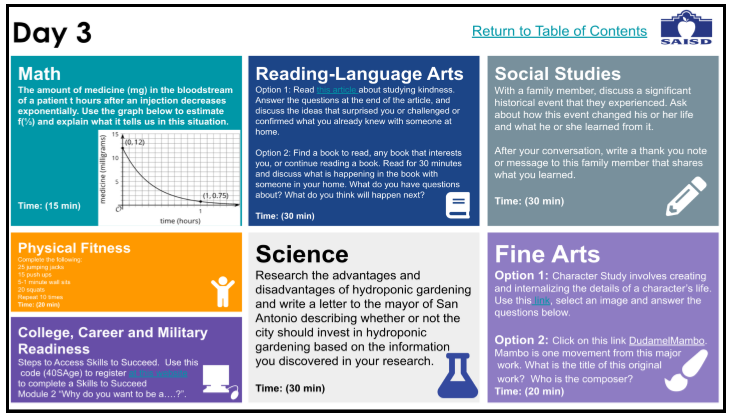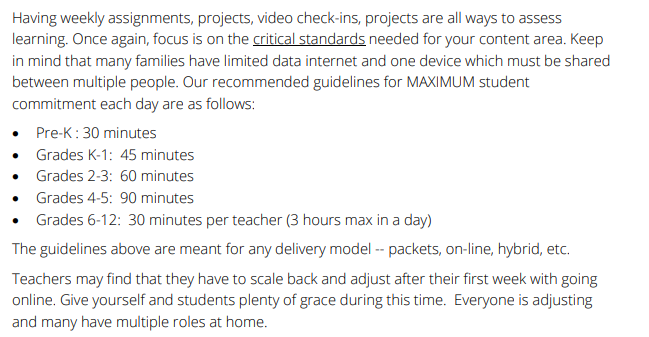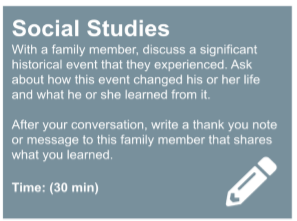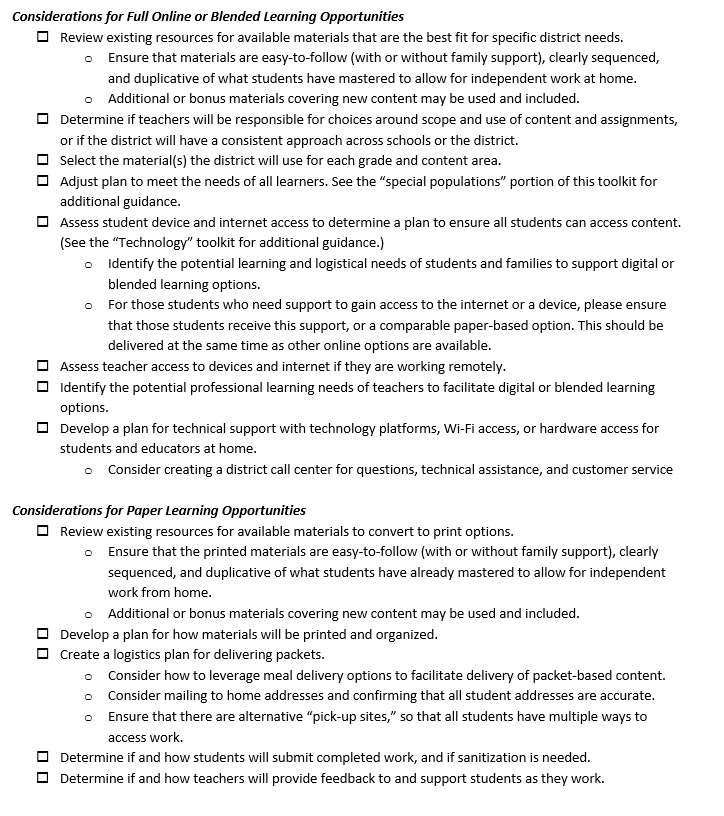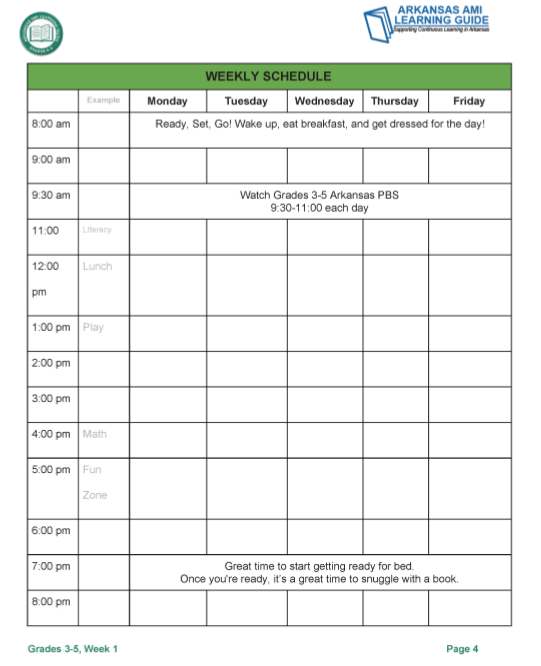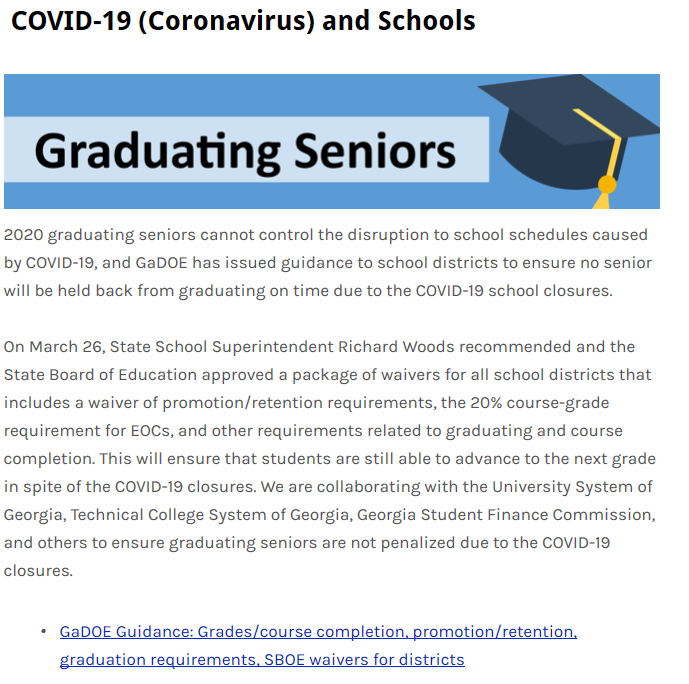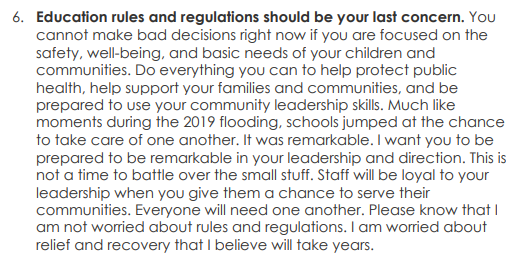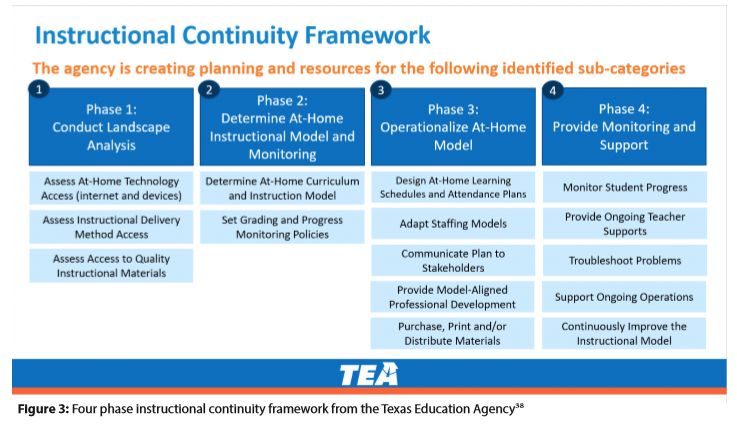NEW REPORT from @mit_tsl : Remote Learning Guidance from State Education Agencies in the #COVID19 Pandemic. We reviewed recommendations for schools from all 50 states. Here& #39;s what we found... https://tsl.mit.edu/covid19/ ">https://tsl.mit.edu/covid19/&... 1/
We published three things: 1) a report summarizing recommendations and findings: https://edarxiv.org/437e2/ ,">https://edarxiv.org/437e2/&qu... 2) an open data set with all of our data: http://bit.ly/StateEdCOVID ,">https://bit.ly/StateEdCO... and 3) a interactive map with links to guidance from all 50 states 2/
Over the last week, with a big team, we read as much as we could and did some preliminary analysis on what state agencies are recommending that schools do in regards to learning. We found lots of consensus, one major area of divergence, and several emerging issues. 3/
The agreement: schools should do some form of learning https://abs.twimg.com/emoji/v2/... draggable="false" alt="🧑🎓" title="Student" aria-label="Emoji: Student">, that will need to happen through online
https://abs.twimg.com/emoji/v2/... draggable="false" alt="🧑🎓" title="Student" aria-label="Emoji: Student">, that will need to happen through online  https://abs.twimg.com/emoji/v2/... draggable="false" alt="💻" title="Personal computer" aria-label="Emoji: Personal computer"> and offline
https://abs.twimg.com/emoji/v2/... draggable="false" alt="💻" title="Personal computer" aria-label="Emoji: Personal computer"> and offline  https://abs.twimg.com/emoji/v2/... draggable="false" alt="📜" title="Scroll" aria-label="Emoji: Scroll">
https://abs.twimg.com/emoji/v2/... draggable="false" alt="📜" title="Scroll" aria-label="Emoji: Scroll"> https://abs.twimg.com/emoji/v2/... draggable="false" alt="📺" title="Television" aria-label="Emoji: Television"> options, attention to wellbeing and equity should be central
https://abs.twimg.com/emoji/v2/... draggable="false" alt="📺" title="Television" aria-label="Emoji: Television"> options, attention to wellbeing and equity should be central  https://abs.twimg.com/emoji/v2/... draggable="false" alt="🚸" title="Children crossing" aria-label="Emoji: Children crossing">, and schools must attend to the needs of students with disabilities
https://abs.twimg.com/emoji/v2/... draggable="false" alt="🚸" title="Children crossing" aria-label="Emoji: Children crossing">, and schools must attend to the needs of students with disabilities  https://abs.twimg.com/emoji/v2/... draggable="false" alt="♿️" title="Wheelchair symbol" aria-label="Emoji: Wheelchair symbol">. 4/
https://abs.twimg.com/emoji/v2/... draggable="false" alt="♿️" title="Wheelchair symbol" aria-label="Emoji: Wheelchair symbol">. 4/
Every state agrees that student well-being comes first. As WV says, "Feeding children is our number one priority." We were heartened to read over and over again state leaders asking schools to consider issues of equity in every decision and to make this work "for ALL children" 5/
Vermont and Minnesota offered "equity lens toolkits" to help schools think about their teaching and policy decisions. (VT: https://education.vermont.gov/sites/aoe/files/documents/edu-equity-lens-tool.pdf;">https://education.vermont.gov/sites/aoe... MN: https://education.mn.gov/MDE/dse/health/covid19/AcademicStandardsCOVID-19Resources/MDE032230)">https://education.mn.gov/MDE/dse/h... 6/
There has been some discussion that the US Dept. of Ed might waive certain special education guidelines. (see NYT: https://www.nytimes.com/2020/04/02/us/politics/special-education-coronavirus.html">https://www.nytimes.com/2020/04/0... ) But reading from states, there was universal emphasis on the requirement to provide a free and appropriate public education. 7/
The big  https://abs.twimg.com/emoji/v2/... draggable="false" alt="❓" title="Red question mark ornament" aria-label="Emoji: Red question mark ornament">: should schools facilitate enrichment (skills review, family projects, and interest-driven learning)? Or should they teach new material aligned to standards? Here& #39;s a clip from MA on enrichment, and VA on forward progress. 8/
https://abs.twimg.com/emoji/v2/... draggable="false" alt="❓" title="Red question mark ornament" aria-label="Emoji: Red question mark ornament">: should schools facilitate enrichment (skills review, family projects, and interest-driven learning)? Or should they teach new material aligned to standards? Here& #39;s a clip from MA on enrichment, and VA on forward progress. 8/
There are equity and efficacy arguments behind these two positions. New Mexico, for instance, argued that homes aren& #39;t equipped to do "school" well, so schools and families should create learning experiences that homes would be good at. 9/
The case for forward progress is that if schools don& #39;t keep teaching to standards, then children will fall behind, &there will be more remediation to be done in the fall. Some states, like AL, are encouraging schools to focus on "essential standards" https://drive.google.com/file/d/1ZufRLahwj884iLKjpOEp5l6EX-L1zNjP/view">https://drive.google.com/file/d/1Z... 10/
We encourage schools to reflect on this question of enrichment versus new material. It gets at the fundamental question: "What is the role of schools as they provide learning during a pandemic?" But two important caveats to these positions. 11/
First, policy differences that look wide often appear much more narrowly in practice. Many schools and teachers will do whatever they can, or whatever works, regardless of state policy. 12/
We also expect to see more differences between high schools (new material) and primary schools (enrichment), and between affluent areas (which have the tech to support teaching new material) and poverty-impacted areas (which in many cases won& #39;t). 13/
Second, no state is being dogmatic about this. MA encourages enrichment, but in the next sentence suggests that some high school courses might choose to proceed. Texas advocates for "At-home schools" but also featured this daily 11th/12th grade plan from San Antonio ISD 12/
Let& #39;s dig on this example, because we think has some important features. First, time: we& #39;re seeing several states recommend 3-4 hours maximum learning time for high schools, with increasingly shorter times for elementary. 13/
We were encouraged to see many places recommend exercise and art as part of the daily routine, to fit in that max 3 hours. [to consider: if US kids need daily art  https://abs.twimg.com/emoji/v2/... draggable="false" alt="🧑🎨" title="Artist" aria-label="Emoji: Artist"> and exercise
https://abs.twimg.com/emoji/v2/... draggable="false" alt="🧑🎨" title="Artist" aria-label="Emoji: Artist"> and exercise  https://abs.twimg.com/emoji/v2/... draggable="false" alt="🏋️♀️" title="Woman lifting weights" aria-label="Emoji: Woman lifting weights"> in hard times, why not in good times?] 14/
https://abs.twimg.com/emoji/v2/... draggable="false" alt="🏋️♀️" title="Woman lifting weights" aria-label="Emoji: Woman lifting weights"> in hard times, why not in good times?] 14/
The San Antonio social studies lesson seemed like a good one for a pandemic: interview a family member about a historical event, and write a thank you note. It promotes family connections, social cohesion, listening, writing, and interest-driven learning...15/
It has short instructions which makes translation easier for English language learners, and it could fit in a text message for students without internet. It& #39;s extensible--students could easily interview more family members on more topics, or research the events more deeply. 16/
Our intuition is that many good lessons during shelter-in-place will look like this: short, rich, extensible, skills focused, promoting human connection. Is it standards-aligned? If you squint, maybe to skill standards. But it& #39;s good. 17/
We read all kinds of documents. Illinois ( https://www.isbe.net/Documents/RL-Recommendations-3-27-20.pdf)">https://www.isbe.net/Documents... and Kansas ( https://www.ksde.org/Portals/0/Communications/Continuous%20Learning%20Documents/Continuous%20Learning%20Task%20Force%20Guidance.pdf?ver=2020-03-27-135544-943)">https://www.ksde.org/Portals/0... have published comprehensive task force reports. Massachusetts published a short set of high level principles ( https://massteacher.org/-/media/massteacher/files/coronavirus/remote-learning-recommendations.pdf?la=en).">https://massteacher.org/-/media/m... 18/
Tennessee and Minnesota have "checklists" or templates for schools to use in their planning. (MN: https://education.mn.gov/mdeprod/idcplg?IdcService=GET_FILE&dDocName=MDE032166&RevisionSelectionMethod=latestReleased&Rendition=primary)">https://education.mn.gov/mdeprod/i... (TN: https://www.tn.gov/content/dam/tn/education/health-&-safety/Academics_Toolkit_3.23.20.pdf)">https://www.tn.gov/content/d... 19/
Some of our favorites were short, humanizing video messages from commissioners or teachers of the year. Montana& #39;s TOY remind teachers that it& #39;s calving season, which means older students and parents will be working out in the fields. https://www.youtube.com/watch?v=xovpiFIpFdo&feature=youtu.be">https://www.youtube.com/watch... 20/ https://www.youtube.com/watch...
Nearly every state recommends both online and offline options for families. Arkansas& #39;s asst. commish reminds schools that her reasonably well-off family doesn& #39;t have enough devices and bandwidth for kids and parents to always be on. https://www.youtube.com/watch?v=8IQZilh0lS4">https://www.youtube.com/watch... 21/
For online options, many states recommend a focus on asynchronous learning, where students proceed at their own pace, reserving synchronous connections for occasional celebrations, and small group teacher check in. 22/
For offline options, the three approaches are worksheet packets, family projects, and television-based learning. Arkansas has synced with their PBS station to provide programming by grade level band; 90 minutes of K2, then 90min of 3-5, then 90 minutes of K8. 23/
If there was one area where we thought states should offer stronger guidance and more feedback, it was in serving English Language Learners. While nearly every state emphasized special education, fewer explicitly referenced ELLs or provided translation examples, etc. 24/
About half of states have started publishing guidance on grades and graduation, and the hallmarks here are "flexibility" and, to use a Kansas term, "grace." Widespread agreement that seniors should be held harmless and allowed to graduate (albeit, without ceremonies). 25/
Many states are advocating pass/fail or credit/no credit grading, or encouraging competency-based approaches to making up lost work. This fits in a broader pattern of encouraging flexibility. Here& #39;s from Nebraska, about doing the right thing over adhering to policy. 26/
We also valued states that reminded folks to think of thing as an ongoing process. Texas, for instance, encourages schools to plan, then implement, and provide ongoing monitoring and support. 27/
We have three big recommendations for states as they continue this work. Continue to focus on issues of equity, continue to acknowledge the challenges of doing schooling from home, and communicate clearly and concisely with stakeholders. 28/
Mostly, we tried to share the terrific work that state agencies are doing. There are examples throughout of specific states doing particularly great things, & we hope it& #39;s helpful for SEAs to see each other& #39;s work. http://bit.ly/StateEdCOVID ">https://bit.ly/StateEdCO... has lots of links and snippets. 29/

 Read on Twitter
Read on Twitter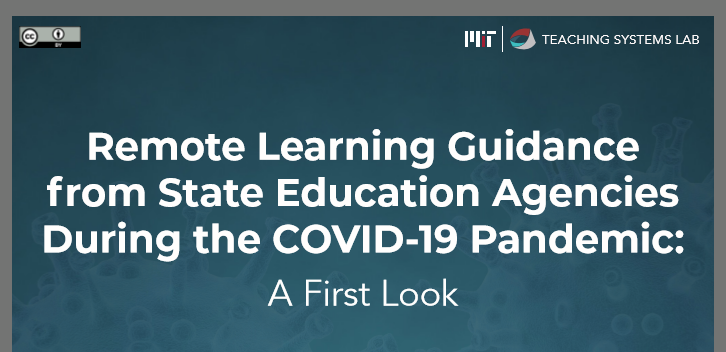
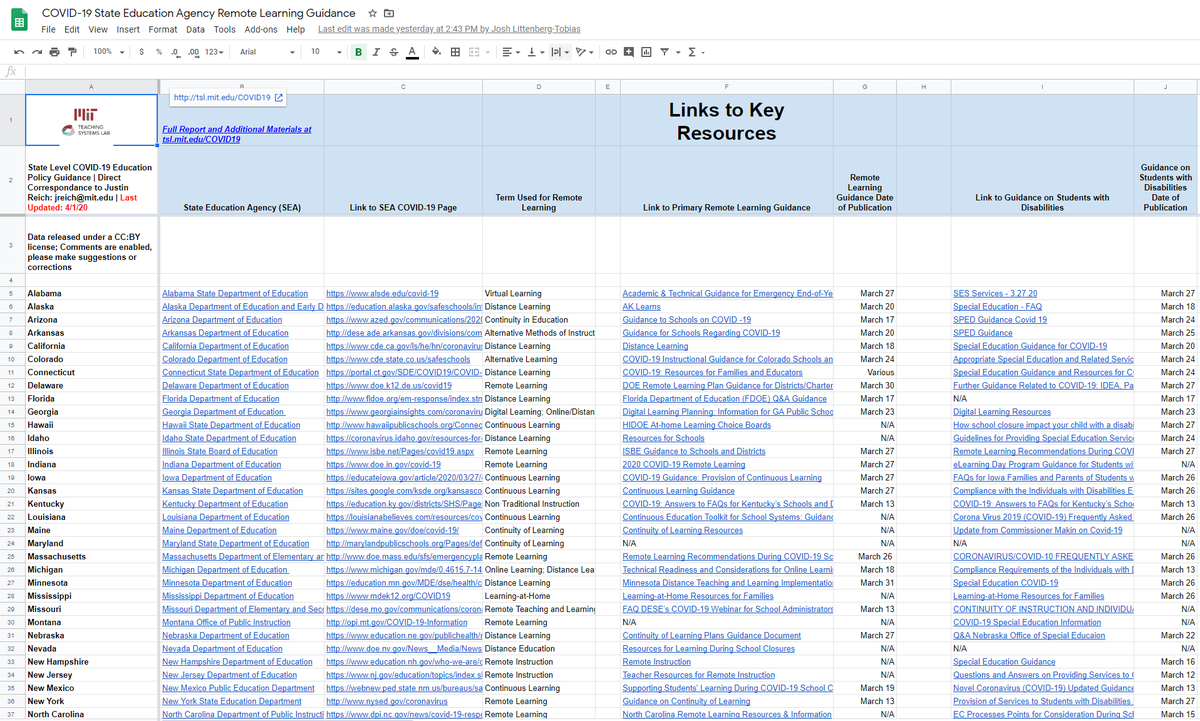
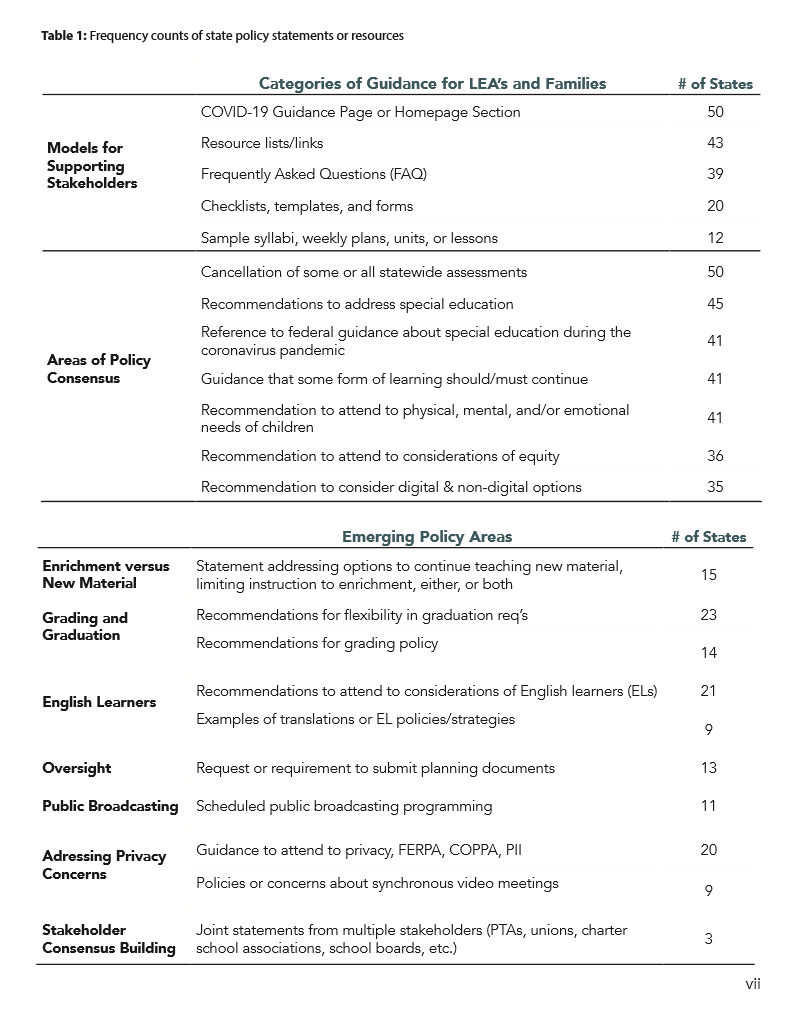
 , that will need to happen through online https://abs.twimg.com/emoji/v2/... draggable="false" alt="💻" title="Personal computer" aria-label="Emoji: Personal computer"> and offline https://abs.twimg.com/emoji/v2/... draggable="false" alt="📜" title="Scroll" aria-label="Emoji: Scroll">https://abs.twimg.com/emoji/v2/... draggable="false" alt="📺" title="Television" aria-label="Emoji: Television"> options, attention to wellbeing and equity should be central https://abs.twimg.com/emoji/v2/... draggable="false" alt="🚸" title="Children crossing" aria-label="Emoji: Children crossing">, and schools must attend to the needs of students with disabilities https://abs.twimg.com/emoji/v2/... draggable="false" alt="♿️" title="Wheelchair symbol" aria-label="Emoji: Wheelchair symbol">. 4/" title="The agreement: schools should do some form of learninghttps://abs.twimg.com/emoji/v2/... draggable="false" alt="🧑🎓" title="Student" aria-label="Emoji: Student">, that will need to happen through online https://abs.twimg.com/emoji/v2/... draggable="false" alt="💻" title="Personal computer" aria-label="Emoji: Personal computer"> and offline https://abs.twimg.com/emoji/v2/... draggable="false" alt="📜" title="Scroll" aria-label="Emoji: Scroll">https://abs.twimg.com/emoji/v2/... draggable="false" alt="📺" title="Television" aria-label="Emoji: Television"> options, attention to wellbeing and equity should be central https://abs.twimg.com/emoji/v2/... draggable="false" alt="🚸" title="Children crossing" aria-label="Emoji: Children crossing">, and schools must attend to the needs of students with disabilities https://abs.twimg.com/emoji/v2/... draggable="false" alt="♿️" title="Wheelchair symbol" aria-label="Emoji: Wheelchair symbol">. 4/" class="img-responsive" style="max-width:100%;"/>
, that will need to happen through online https://abs.twimg.com/emoji/v2/... draggable="false" alt="💻" title="Personal computer" aria-label="Emoji: Personal computer"> and offline https://abs.twimg.com/emoji/v2/... draggable="false" alt="📜" title="Scroll" aria-label="Emoji: Scroll">https://abs.twimg.com/emoji/v2/... draggable="false" alt="📺" title="Television" aria-label="Emoji: Television"> options, attention to wellbeing and equity should be central https://abs.twimg.com/emoji/v2/... draggable="false" alt="🚸" title="Children crossing" aria-label="Emoji: Children crossing">, and schools must attend to the needs of students with disabilities https://abs.twimg.com/emoji/v2/... draggable="false" alt="♿️" title="Wheelchair symbol" aria-label="Emoji: Wheelchair symbol">. 4/" title="The agreement: schools should do some form of learninghttps://abs.twimg.com/emoji/v2/... draggable="false" alt="🧑🎓" title="Student" aria-label="Emoji: Student">, that will need to happen through online https://abs.twimg.com/emoji/v2/... draggable="false" alt="💻" title="Personal computer" aria-label="Emoji: Personal computer"> and offline https://abs.twimg.com/emoji/v2/... draggable="false" alt="📜" title="Scroll" aria-label="Emoji: Scroll">https://abs.twimg.com/emoji/v2/... draggable="false" alt="📺" title="Television" aria-label="Emoji: Television"> options, attention to wellbeing and equity should be central https://abs.twimg.com/emoji/v2/... draggable="false" alt="🚸" title="Children crossing" aria-label="Emoji: Children crossing">, and schools must attend to the needs of students with disabilities https://abs.twimg.com/emoji/v2/... draggable="false" alt="♿️" title="Wheelchair symbol" aria-label="Emoji: Wheelchair symbol">. 4/" class="img-responsive" style="max-width:100%;"/>
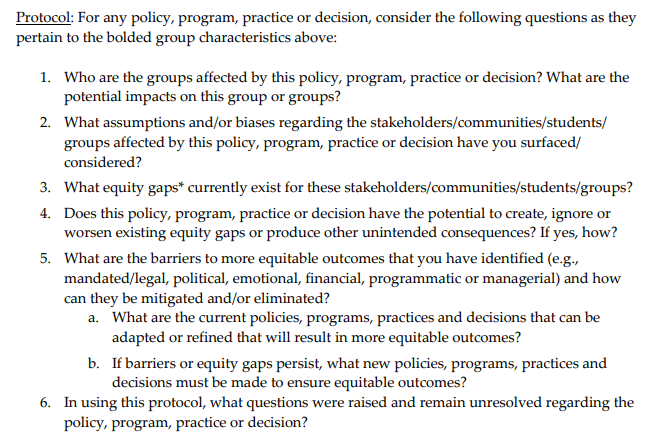
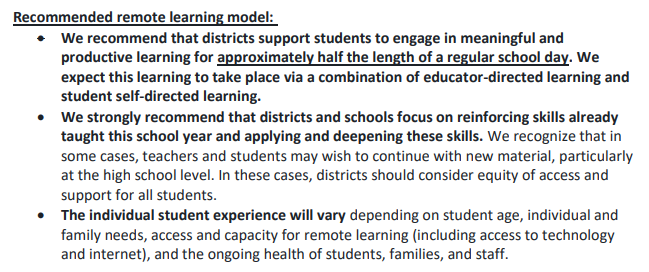 : should schools facilitate enrichment (skills review, family projects, and interest-driven learning)? Or should they teach new material aligned to standards? Here& #39;s a clip from MA on enrichment, and VA on forward progress. 8/" title="The big https://abs.twimg.com/emoji/v2/... draggable="false" alt="❓" title="Red question mark ornament" aria-label="Emoji: Red question mark ornament">: should schools facilitate enrichment (skills review, family projects, and interest-driven learning)? Or should they teach new material aligned to standards? Here& #39;s a clip from MA on enrichment, and VA on forward progress. 8/">
: should schools facilitate enrichment (skills review, family projects, and interest-driven learning)? Or should they teach new material aligned to standards? Here& #39;s a clip from MA on enrichment, and VA on forward progress. 8/" title="The big https://abs.twimg.com/emoji/v2/... draggable="false" alt="❓" title="Red question mark ornament" aria-label="Emoji: Red question mark ornament">: should schools facilitate enrichment (skills review, family projects, and interest-driven learning)? Or should they teach new material aligned to standards? Here& #39;s a clip from MA on enrichment, and VA on forward progress. 8/">
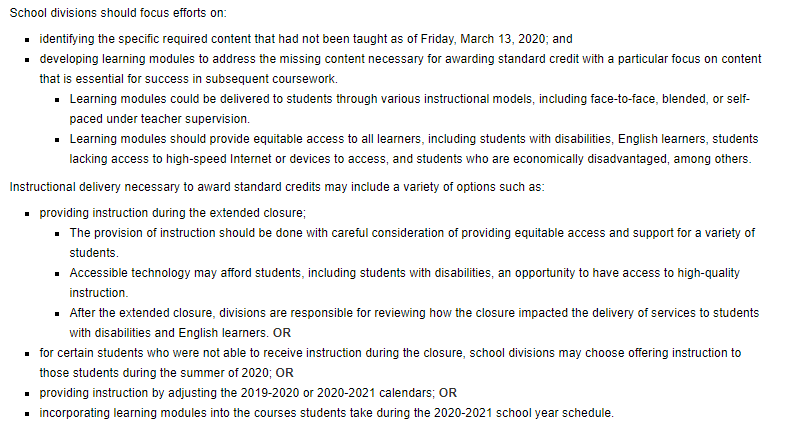 : should schools facilitate enrichment (skills review, family projects, and interest-driven learning)? Or should they teach new material aligned to standards? Here& #39;s a clip from MA on enrichment, and VA on forward progress. 8/" title="The big https://abs.twimg.com/emoji/v2/... draggable="false" alt="❓" title="Red question mark ornament" aria-label="Emoji: Red question mark ornament">: should schools facilitate enrichment (skills review, family projects, and interest-driven learning)? Or should they teach new material aligned to standards? Here& #39;s a clip from MA on enrichment, and VA on forward progress. 8/">
: should schools facilitate enrichment (skills review, family projects, and interest-driven learning)? Or should they teach new material aligned to standards? Here& #39;s a clip from MA on enrichment, and VA on forward progress. 8/" title="The big https://abs.twimg.com/emoji/v2/... draggable="false" alt="❓" title="Red question mark ornament" aria-label="Emoji: Red question mark ornament">: should schools facilitate enrichment (skills review, family projects, and interest-driven learning)? Or should they teach new material aligned to standards? Here& #39;s a clip from MA on enrichment, and VA on forward progress. 8/">

